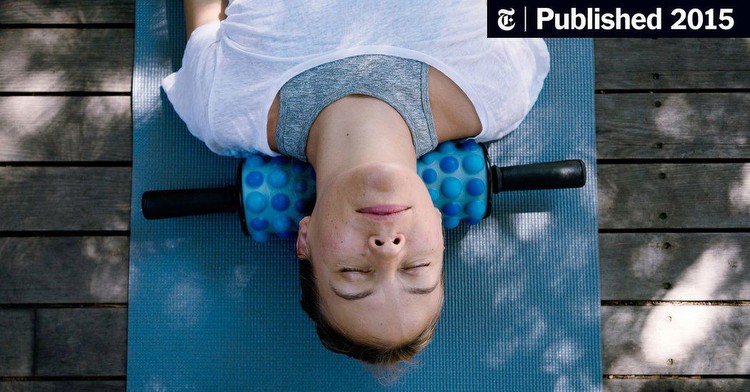A $365 Foam Roller? It Exists

Donald Fowler, the buyer at Nest, an upscale furniture and accessories store in Dallas, never envisioned offering fitness equipment alongside $498 Lazy Susans made from recycled wine barrels and $28,000 crystal foosball tables with 24-karat gold handles. As a runner, Mr. Fowler understood the fitness world’s yen for cheap, utilitarian props like the foam roller — the often grimy-looking logs used to massage tight muscles and connective tissue — but they were to be left at the gym. “Those big black wormy things,” Mr. Fowler said with obvious distaste, “are not something you’d want lying around your living room.”
But he recently found a roller that changed his mind: one that looks like an overengineered bath mat wrapped around a rolling pin, a nubby silicone confection he prefers to describe as “well designed, upbeat, almost 1960s mod.” Instead of the typical factory-made extruded foam, the RolPal, as it’s called, is made by hand in — wait for it — Brooklyn. Price: $365.
“Most everybody now has some sort of fitness regimen that they either cling to or aspire to,” Mr. Fowler said. “There’s a great opportunity for luxury that makes sense to be brought into that arena.”
Amazon offers more than 1,000 kinds of foam rollers for self-massage in various colors and densities, from swimming-pool-noodle gentle to digging-in-an-elbow painful. Most cost less than $30. But exclusive gyms, hotels and 1-percenters are snapping up the RolPal, which can be made just six at a time over two to three days in Sunset Park. The pop star Shakira has one with her name laser-etched into it. At E, Equinox’s $26,000-per-year club at Columbus Circle, which is entered by a retina scan, there are seven on the floor for its 50 members.
This week, Anna Kaiser, whose $475-per-month dance-cardio classes have cheeky names like “Sweat Dream” and “4Play,” will begin using the rollers in a class in her new NoMad studio called “Sexy Mofo Fascia Release.” (The fascia are the connective tissues that surround and separate muscles.) Ms. Kaiser said she thinks the showy props will hook clients. “It’s like: ‘Wow, this looks so cool. What is this?’ ” she said. “It pulls you in.”
In a world where trainers often tell clients that if they’re not thinking four-letter words while foam-rolling, they’re doing it wrong, the two-year-old RolPal — whose fingertip-size bumps supposedly let it get deeper, and thus more torturously, into muscles — has also become something of a badge of honor.
Dae Mellencamp, a former president of Vimeo, said she tried all manner of foam roller, from the softer blues and greens to the harder, denser black, on up to one with a metal bar, hoping for relief. Then she found RolPal.
“There’s just nothing like it, and nothing goes as deep,” said Ms. Mellencamp, who is training for a mud run. “It’s like an addiction.”
She added, “The price is intimidating, but it’s been utterly and completely worth it.”
That may be subjective. Duane C. Button, an assistant professor of exercise science at Memorial University of Newfoundland, who has published studies on the effectiveness of foam rolling (in short, it works), said he’d stick with the cheap version until research suggests otherwise. His studies, after all, were done with a $25 roller.
Visit RolPal’s president, Dièry Prudent, and it’s easy to understand the roller’s genesis. Mr. Prudent, a personal trainer who lives in a featured-in-interiors-magazines 1870s brownstone in Park Slope, Brooklyn, is the sort of exacting guy who bristles if you refer to the roller as a tool. “Tools are for carpenters,” he said. “This is an instrument.”
When a reporter arrived for a demonstration breathless, late and sweaty, Mr. Prudent, 53, handed over a glass of water and gestured toward a platter of Paleo-diet-friendly snacks: strips of bresaola, the meat as intricately folded as origami, so uniformly spaced it looked as if a ruler had been involved. “Relax,” he said. “This is supposed to be an experience.”
Mr. Prudent, who destroyed his right knee playing basketball on Bedford-Stuyvesant blacktop and then as a running back on his high school football team, was always on the hunt for a better rehab tool, ordering everything he could find off the Internet. About 12 years ago, he even concocted his own, made of steel pipes, foam pads and bicycle handlebar grips. It looked like a medieval torture device.
His wife, Mariza Scotch, an accessories designer and the chief creative director at Skagen, a Danish lifestyle brand, was unimpressed. Ms. Scotch can’t stand “visual dissonance,” he said, so he worried he’d have to rescue it from the trash or the recycling bin, like some of his other projects.
A few years ago, visiting the workshop of the industrial artist Fabrice Covelli, whom Mr. Prudent met at a yard sale, he spotted a clear acrylic lamp with raised red, yellow and orange gel-like bumps, and was inspired. The pair spent weeks tinkering with textures, densities (one rejected version felt as hard as marbles) and dot locations on a prototype, printing out acupressure charts, acupuncture maps and trigger-point maps and trying to see where they converged. Finally, they settled on 10 rows of different-size dots, 100 in all. Because the dots are in two shades of blue, the silicone must be hand-piped from squeegee bottles into an ice-cube-like tray, where it then cures overnight. Then a layer of charcoal gray is applied, flattened using a ruler and pulled like pizza dough. Finally, assembling each RolPal — not including the time to hand-cut the steel rods and mold the end caps — takes an hour.
Mr. Prudent said he still wasn’t thinking of selling the fitness objet d’art; he was merely “just crazy about it” and wanted to show it off.
He carried the roller around Europe one summer in a specially adapted Messermeister canvas knife roll, its ends peeking out like a poodle in a handbag, and inevitably he was asked about it in outdoor cafes. After dinners at the couple’s home with owners of Italian leather factories and fashion publicity agents, part of Ms. Scotch’s work, “instead of handing out limoncello, I’d hand out RolPal sessions,” he said. “And people would be like, ‘Oh my God, I’m coming back again tomorrow.’ ”
He decided to sell the RolPal for $189, but business was slow. His wife, steeped as she was in luxury branding, knew the reason. “Your price point is too low,” she told him. “No one is going to take you seriously unless you charge more money.”
And so the price nearly doubled, to $365 — “a dollar a day for a year,” Mr. Prudent likes to say, though the RolPal should not need to be replaced in a year, he noted. If it does, fans are likely to pay up for another.
“It just hurts so good,” said Ms. Kaiser, the fitness teacher. “Once you use it you can’t go back.”


































